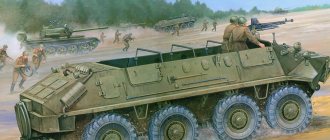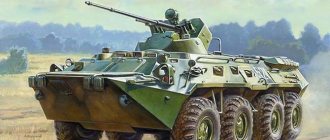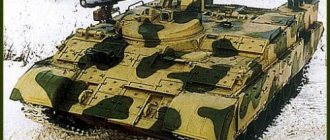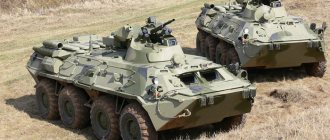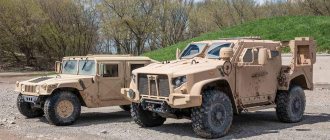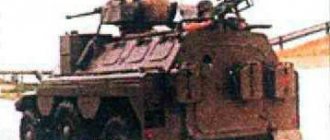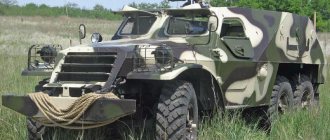Disc BTR-60 (also used on BRDM-1,2) Disc BTR-70 (only one option) Disc BTR-80 (solid cap) Disc BTR-82
Tire - K-58(KI-80) Tire - KI-126
These options are described in the next 4 posts and they are also included in the voting.
Source
Bullet resistance of tires and world experience
This is what an armored car and, in general, any special vehicle with armor has looked like for the last hundred years
| Source: Internet |
| 120-mm self-propelled artillery gun "Phlox" on a wheeled chassis |
| Source: Alexey Zharich / JSC Research and Production Corporation Uralvagonzavod |
An example with an air defense forces vehicle, the photo clearly shows a tiny area of terrain, any explosion on which will produce a sea of fragments, including on the wheels; the missiles, on the contrary, are hidden in the body
| SAM TOR M2 |
| Source: Russian Defense Ministry |
Bare tires everywhere. This is the theme.
The durability of wheels, which often only have 4, is not very great, and several penetrations of just one wheel by not the most advanced bullets will turn the car into a pillbox. But I want to sit (no, of course, drive) in a car whose mobility under any fire, like the main armored hull, will not let you down.
Of course, there are systems to protect wheels from explosions and bullets. The very concept of “bullet-resistant tires” is widely known. It is also widely known that their durability is much lower than the weapons available in the arsenal. A sniper, or a mine, or an AGS will leave any vehicle in place, like many vehicles: to destroy immobilized targets. If the class of the vehicle is high, then its body and glass will withstand most of the weapons available to all armies of all countries in the world. And as before, the shell will turn the wheels of an armored personnel carrier into a sieve, and machine gun fire will burn hundreds and thousands of convoy trucks in local wars, even if their cabins have been reinforced, even if these are not civilian, but special combat vehicles. Well, there are no wheels stronger than a steel body, which, being steel, doesn’t like calibers such as 12.7 mm. There are countless thousands of similar machine guns in the world, as well as other things.
Wheels hidden behind steel barriers are no longer so widely known. The reason is elementary: when such a shield hits the ground, it immediately tears off at not the highest speeds. And if not, then the stones will get stuck, or the dirt will freeze tightly (without quotes). There are actually many reasons why the whole world drives like in the first picture.
How to solve the problem of increasing the protection of the wheel to equal and greater than the body (weapons of destruction are also not infinite and are exhausted in their actual capabilities). The solution is not given instantly.
It remains to combine freedom of movement and a solid rigid frame, no less and even more resistant to fire than an armored hull. But how?. Among those advertised in Russia, you can take the Typhoon (purely for example), a truck with a solid steel frame in addition to the wheels.
- You can stick another layer of “bullet-resistant rubber” on the side of the wheel.
then add it, but as a bulwark (like on tanks) with support on the hull and not forgetting to keep support for the steering wheel on the axle so that it turns.
add everything for the working surface of the wheel too.
it was possible to count a three-fold increase in protection from bullets and shrapnel, and even count protection from fire and explosion (the wrong grams of explosives would tear the wheel off the axle).
However, it is possible to add armor steel to item number 4 (for special vehicles, more stable options such as STB and other more durable, but more expensive, and lighter weight options are possible). And make this steel bend freely. Why is normal armor hung on a rubber bulwark, cut into pieces? Even on one side, odd on the opposite. You can imagine a handkerchief all trimmed with buttons on one side - obviously it will become difficult to pierce and it is equally obvious that such a handkerchief will wrinkle freely under pressure from any side in any direction. In principle, this is already an option for protecting wheels with effective armor from any side without any loss in mobility or maintainability (both the wheel and protection). Without serious problems with daily temperature changes around zero, without loss of protection when driving through difficult terrain of any landscape.
The theoretical part makes it possible to create a set of fundamentally different steel but rubber armor from the described ones with wheel durability at least several times greater than that of an armored personnel carrier or an armored car, the actual durable body, especially an air defense complex and special vehicles for special operations or convoying strategic elements of the country’s security as a whole. Of course, such heavy protection can be removed in peacetime.
Everyone who comes under fire wants to have all 4 wheels, not 3 or 2 or 3.5. Why body armor if the car stopped, and from a means of protection against a stray bullet turned into the ideal dream of a grenade launcher. Naturally, if you have the finances, the weight of the protection on the wheel may not weigh much more than the soldier’s personal armor (less than 10 kg for a comparable area). The net carrying capacity of the machine is often more than 2 or even 8 tons. And the price of artillery, air defense vehicles and, of course, vehicles for evacuating the wounded from the front line (in Russia there are such vehicles, they are low, and on wheels, and protect against many factors of destruction), the price of such vehicles is enormous, there are options with a price of tens of millions.
There are also many known “light” wheeled vehicles that are several times cheaper to operate than their tracked counterparts that are not killed in battle (the chassis of a rural tractor is immortal in comparison with the chassis of a combat wheeled tank). The described patent offers their wheels protection equal and stronger than the main armored hull, without loss of mobility.
Source
The BTR-80 armored personnel carrier is a wheeled amphibious combat vehicle designed to transport motorized rifle units and provide fire support to them on the battlefield, and to conduct combat from a vehicle. When creating the BTR-80, the experience of operating the BTR-60 and BTR-70 armored personnel carriers in various climatic conditions and their combat use in various countries of the world was widely used.
In the frontal part of the armored personnel carrier there is a control compartment, in which the driver and commander of the armored personnel carrier are located. The troop compartment is combined with the fighting compartment and is located in the central part of the vehicle. The engine and transmission compartment is located in the rear of the combat vehicle.
All of the above-mentioned layout solutions provide the BTR-80 with the following positive qualities:
- good visibility and high landing activity, low gas pollution in the habitable compartments, good buoyancy (providing and maintaining trim to the stern), desired angles of maneuverability due to the rear placement of the power plant;
- uniform wheel load required for high maneuverability of the vehicle;
- high ability to overcome trenches (up to 2 m) and combat survivability of the propulsion unit during explosions due to the use of a four-axis wheeled propulsion system;
- the ability to follow tanks along tank tracks and good lateral stability (roll up to 25) due to the wide track, smooth bottom and high ground clearance.
The combat crew is boarded and disembarked through the top hatches in the hull roof, or through the side doors, which allow the combat crew to board and disembark even while the vehicle is moving.
The BTR-80 is armed with a coaxial installation of a 14.5 mm KPVT heavy machine gun and a 7.62 mm PKT (PKTM) machine gun with guidance angles of 360° horizontally and from +60° to -4° vertically. The combat crew can use personal weapons under the cover of the vehicle's armor through loopholes in the sides of the hull or to hit low-flying targets through the loopholes in the upper hatches of the vehicle. The armored personnel carrier is equipped with a TKN-4GA combined gunner's sight to ensure accurate firing of weapons day and night.
The hull and turret armor reliably protects the combat crew from 7.62 mm caliber bullets and shell fragments, and the frontal armor also protects from 12.7 mm caliber bullets.
The high mobility of the armored personnel carrier is achieved through the use of an eight-wheel propulsion unit with all-wheel drive (8x8), a powerful and economical diesel engine, independent torsion bar suspension on wishbones and combat-resistant tubeless tires. The BTR-80 can cross water obstacles on the move and without preparation.
Bullet-resistant tubeless tires KI-80N or KI-126 with adjustable pressure allow the BTR-80 to continue moving after being hit by bullets of all calibers and completely lacking air for up to 200 kilometers.
A four-axle propeller with an 8x8 wheel arrangement, a spaced main drive with wheel gearboxes ensured a smooth bottom, and an independent torsion bar suspension, high ground clearance and a track width close to that of a tank made it possible to move along the tracks of tank columns.
To self-extricate a stuck armored personnel carrier, there is a winch with a traction force of 4 - 6 tons.
On the BTR-80 chassis, combat and logistics support vehicles have been developed and produced, which form a family of vehicles: an armored personnel carrier for a battalion commander, a radiation and chemical reconnaissance vehicle, various communications, control and command and staff vehicles, an armored medical vehicle, an armored repair and recovery vehicle and 120 mm self-propelled artillery gun "Nona-SVK".
ARMORED TRANSPORTER BTR-80
The BTR-80 is a wheeled amphibious combat vehicle designed to transport motorized rifle units, marines and their fire support on the battlefield. The armored personnel carrier is armed with a 14.5 mm KPVT machine gun and a coaxial 7.62 mm PKTM machine gun installed in the turret. Weapon pointing angles range from –4° to +60° vertically and 360° horizontally.
The vehicle is equipped with communications equipment, systems for protection against weapons of mass destruction (WMD), launching smoke grenades, providing habitability, fire extinguishing, as well as water pumping equipment. The combat crew of the BTR-80 is 10 people (vehicle commander, driver, gunner and seven motorized riflemen).
According to the purpose and location of units and equipment, the armored personnel carrier is divided into three sections: control, combat, and power plant. Protection of the combat crew from the effects of enemy fire weapons, as well as the damaging factors of weapons of mass destruction, is ensured by an armored sealed housing, inside of which excess pressure of purified air is created.
The armor of the hull and turret protects against enemy small arms fire, mine and shell fragments. High mobility of the vehicle is achieved by using an all-wheel drive eight-wheel drive, a powerful and economical diesel engine, independent torsion bar suspension of all wheels on wishbones with increased travel, and the use of fire-resistant tubeless tires. Thanks to these measures, the BTR-80 can continue to move and carry out a combat mission at a distance of at least 200 km, not only in the event of bullet damage to the tires, but also in the event of a mine explosion, including anti-vehicle mines.
The vehicle is equipped with embrasures with ball bearings for firing from machine guns and machine guns. In the upper hatches of the fighting compartment there are hatches for firing from machine guns at high-lying targets. The compartment itself provides space for stowing ammunition for KPVT and PKTM machine guns, a man-portable anti-aircraft missile system, eight machine guns, ammunition for machine guns and assault rifles, a hand-held anti-tank grenade launcher and rounds for it, hand grenades and other equipment.
Landing from an armored personnel carrier is possible through two top and two double-leaf side hatches. To self-extricate a stuck armored personnel carrier, there is a winch with a traction force of 4 - 6 tf.
Source
BTR-80
BTR-80
In the early 1980s, after successful factory and state tests, the BTR-80 armored personnel carrier, developed at the GAZ Design Bureau under the leadership of I.S. Mukhin and E.M. Murashkin, was adopted into service by the Soviet Army. The manufacturing enterprise was determined to be AMZ - Arzamas Machine-Building Plant. The first production BTR-80 left the factory floor on February 24, 1984.
The BTR-80 (GAZ-5903) is a modernized version of its predecessor, the BTR-70 armored personnel carrier. The vehicle's layout, hull design, armament, and chassis have not undergone major changes. The dimensions of the car have remained practically the same. By the way, when evaluating them, a correct comparison is necessary. Thus, in some reference books the height of the BTR-70 is indicated as 2235 mm, and the BTR-80 as 2460 mm. In the first case, this is the height of the vehicle at full weight on the roof of the tower; in the second, this is the height of the empty vehicle according to the TNPT-1 instrument. The height of armored personnel carriers at full weight according to the specified observation device is 2320 and 2350 mm, respectively. Notable external differences of the BTR-80 include double-leaf doors for landing and disembarking troops on the sides of the hull and seven hatches with ball joints for firing personal weapons in the front and side panels. The hatches above the troop compartment are also located differently, in the covers of which there are hatches for firing from machine guns at high-lying targets.
Armored personnel carrier BTR-80 early releases. Noteworthy are the wave-reflective shield and headlight guards, similar to the BTR-70
All production BTR-80 armored personnel carriers are equipped with an autonomous BPU-1 turret machine gun mount, designed to combat ground and low-flying air targets. The BPU-1 is equipped with a 14.5 mm KPVT machine gun and a coaxial 7.62 mm PKT machine gun. The longest sighting range when firing from a KPVT machine gun at ground targets is 2000 m, from a PKT - 1500 m, at air targets from a KPVT - 1000 m. The KPVT ammunition consists of 500 cartridges in belts in 10 boxes, and the PKT - from 2000 cartridges in belts in 8 boxes. Machine guns can be aimed vertically in the range from -4° to +60°, and horizontally - 360°. Guidance mechanisms are manual. For shooting, a 1PZ-2 sight is used, which ensures the destruction of both ground and air targets. To the left of the sight, in the wall of the turret machine gun mount there is a TNP-205 surveillance device, and in the roof there is a TNPT-1 device, designed for the turret gunner to monitor the road and terrain located in the rear viewing sector. On the rear wall of the tower there are 6 ZD6 launchers of the 902V “Tucha” system for launching 81-mm smoke grenades. The weight of the BPU-1 in running order is 540 kg.
The most important and fundamental changes in the design of the BTR-80 remained invisible to the eye. Unlike the BTR-70, the power plant on this vehicle consists of one diesel 8-cylinder V-shaped four-stroke liquid-cooled KamAZ-7403 engine with a turbocharger rated at 260 hp. at 2600 rpm, working volume 10,850 cm3.
BTR-80 body (front left view):
1 — wave-reflective shield; 2,11 and 12 - embrasures for firing from machine guns; 3 — inspection hatches for the commander and driver; 4 — inspection hatch covers; 5 — socket of the TKN-3 surveillance device; 6 — sockets of the TNPO-115 surveillance device; 7 — turret hatch; 8 and 9 - handrails; 10 — embrasure for firing a machine gun; 13 — upper door leaf of the side hatch; 14 — FVU filter hatch cover; 15 and 20 — tow hooks; 16 and 18 — footrests; 17 — lower door leaf of the side hatch; 19 — headlight guard; 21 — winch cable release hatch cover; 22 — front buffers
(back right view):
1 — rear light socket; 2 — air vent protective shields; 3 — turret installation hatch; 4 — embrasure for firing a machine gun: 5 and 6 — handrails; 7,9 and 11 - embrasures for firing from machine guns; 8 and 14 — footrests; 10 — upper door leaf of the side hatch; 12 — lower door leaf of the side hatch; 13 — niche cover for batteries; 15 — reverse output channel afloat; 16 — towing device pin; 17 — water-jet propulsion valve: 18 — visor of the outlet pipe of the electric water pump; 19 — fuel tank filler cap; 20 - rear buffer
Armored personnel carrier BTR-80. The hatches with ball joints for firing personal weapons are clearly visible
The placement of one engine instead of two also entailed changes in the design of transmission units. It includes a dry double-disc clutch, a five-speed gearbox with synchronizers in 2nd, 3rd, 4th and 5th gears, and a cardan transmission. Instead of two transfer cases, one interaxle two-stage one is installed with differential torque distribution into two streams (on the 1st - 3rd and on the 2nd - 4th axles) and forced differential locking. Locking devices ensure that downshifts are engaged and the center differential is locked only when the front axles are engaged. In order to prevent breakdowns when overloading transmission elements (with a locked differential), the transfer case has a friction clutch - a limiting torque clutch. The transfer case is equipped with a power take-off box for a water-jet propulsion unit and a winch. The main gears of the drive axles are equipped with cam limited-slip differentials. Wheel gearboxes are single-stage, with helical spur gears. Wheels with split rims and tubeless bulletproof pneumatic tires KI-80 or KI-126 sizes 13.00-18. The air pressure in the tires is adjustable from 0.5 to 3 kg/cm2.
Tower installation:
1 — console clamp; 2 — console; 3 — entrance window cover; 4 — sight; 5 — release spring for the KPVT reloading mechanism; 6 — observation device TNPT-1; 7 - roller; 8 - cable; 9 — launcher of system 902В; 10 — bracket for the cradle stopper in a traveling manner; 11 - spring; 12 — cradle stopper; 13 — sleeve link collector; 14 — handle buffer; 15 — handle of the KPVT reloading mechanism; 16 — link collector; 17 — mask seal plug; 18 — balancing mechanism; 19 — rotation mechanism; 20 - flame arrester; 21 — cradle stopper bar
Front view of the BPU-1 turret machine gun mount. To the right of the machine gun mask installation is the embrasure of the 1PZ-2 sight with the armor cover folded up. In the foreground, in front of the commander's hatch, a TKN-3 surveillance device with an OU-ZGA2M illuminator is installed
Rear view of the BPU-1 turret machine gun mount. On the roof of the tower on the left there is a TNPT-1 surveillance device, the embrasure of which is closed by an armored flap. On the rear wall of the tower there is a block of launchers for the 902V “Tucha” system.
View of the roof of the troop compartment. The landing hatch covers and the upper wings of the side doors are folded back
Crew and landing layout:
KO—squad commander; MV - driver mechanic: SN - gunner-gunner BPU-1; SP - machine gunners with PC machine guns; SA - submachine gunners with AKMS assault rifles (AKS-74); SG - grenade launcher; PG - gunner-assistant grenade launcher; AA - embrasures for firing from an AKMS assault rifle (LKS-74); AP - embrasures for firing from a PC machine gun
Independent torsion bar suspension, hydraulic shock absorbers, telescopic, double acting, two each for the wheels of the 1st and 4th axles and one each for the wheels of the 2nd and 3rd axles, wheels of the 1st and 2nd axles - controlled.
The power plant allows a combat vehicle weighing 13.6 tons to reach a maximum speed on the highway of at least 80 km/h. Cruising range on the highway is 600 km.
Movement through water is ensured by the operation of a single-stage water-jet propulsion unit with a four-blade impeller with a diameter of 425 mm. When moving on land, the exit window of the water cannon is closed by an armored flap. When moving through water, closing the damper directs water into the reverse channels. The maximum speed afloat is at least 9 km/h. Cruising range afloat at average engine operating conditions (1800 - 2200 rpm) - 12 hours.
After a fire at the KamAZ engine plant in April 1993, the installation of a YaMZ-238M2 diesel engine with a power of 240 hp was developed on an armored personnel carrier, which had almost no effect on the mobility of the vehicle.
Early production vehicles were equipped with radio stations R-123M and TPU R-124, which were later replaced by R-163-50U and R-174.
In 1994, the BTR-80A armored personnel carrier (GAZ-59029) was put into service. Work on the creation of this machine was carried out by GAZ JSC under the leadership of A. Masyagin. The main difference between the new modification and the BTR-80 is the turret cannon and machine gun mount, designed to combat ground and low-flying air targets. The installation houses a 30-mm 2A72 automatic cannon and a coaxial PKT machine gun. Vertical pointing angles from -5° to +70°. Ammunition - 300 shells and 2000 rounds. All weapons are placed on a carriage located outside the habitable compartment, which reduces gas contamination when firing. The BTR-80A is equipped with a 1PZ-9 day sight and a TPN-3-42 “Crystal” tank night sight, which allows it to hit targets at a range of up to 900 m at night. The combat weight of the vehicle has increased to 14.5 tons.
Simultaneously with the BTR-80A, the BTR-80S was developed - an option for internal troops. Instead of a 30-mm cannon, it is equipped with a KPVT heavy machine gun. However, due to the lack of photographs of this combat vehicle, it is difficult to say whether it is mass-produced.
Since 1990, the troops have been receiving the 2S23 Nona-SVK self-propelled artillery gun (SAO).
BTR-80 1985
Bottom view
Front view
Back view
BTR-80, view from the stern. The jet propulsion valve is open. The steering wheels of the car afloat are clearly visible
Armored personnel carrier BTR-80A
The BTR-80 chassis was used as the basis for its creation. The 120-mm 2A60 rifled gun is mounted in a conical welded turret made of aluminum alloy. The horizontal guidance angle is 70° (35° per side). Vertical guidance is possible within the range from -4° to +80°. Maximum rate of fire - 10 rounds/min. Firing from the self-propelled gun can only be carried out from a place, both from closed firing positions, and direct fire with 120-mm rounds with high-explosive fragmentation shells and 120-mm rounds with high-explosive fragmentation, illumination, smoke and incendiary mines. The maximum firing range of a high-explosive fragmentation projectile ZVOF54 is 8700 m, a high-explosive fragmentation mine is 7100 m. The tower is equipped with a commander's cupola, on the roof of which a PKT machine gun is installed, intended for self-defense. The machine gun is connected by a rod to the TKN-ZA device, which allows targeted shooting by controlling fire from the turret. The vehicle is equipped with the 902B “Tucha” smoke screen system.
As for other modifications of the BTR-80, first of all it is worth mentioning the BTR-80K command armored personnel carrier, intended for the commander of a motorized rifle battalion. Three workplaces are equipped for officers to work. The vehicle is equipped with two R-163-50U radio stations, an 11-m telescopic mast, TNA-4-6 navigation equipment with an indicator tablet, and two R-159 remote VHF radio stations.
Self-propelled artillery gun 2S23 "Nona-SVK". Nizhny Tagil, exhibition "URAL EXPO ARMS 2000"
"Nona-SVK". The barrel of the 120 mm 2A60 gun is raised to the maximum elevation angle. Omsk, exhibition VTTV-Omsk-2003
The armored medical vehicle BMM-80 (GAZ-59039) “Symphony” deserves mention. In addition to the crew, it can transport 7 wounded in the medical department and 2 on the roof on stretchers. Depending on the composition of the medical and sanitary equipment, the BMM can be used for the evacuation of the wounded from the battlefield (BMM-1), as a battalion first aid station (BMM-2) and a mobile dressing room with a medical team and an automatic dressing station AP-2 (BMM-3 ).
In addition, the BTR80KSh command and staff vehicle (GAZ-59032), the armored repair and recovery vehicle BREM-K (GAZ-59033), the radiation and chemical reconnaissance vehicle RKhM-4 (RKhM-4-01), were created on the BTR-80 chassis. unified chassis K1Sh1, short-wave radio station of the operational-tactical control level R-165B, mobile control points PU-12M6 and PU-12M7 of the air defense missile system battery, mobile command and observation post of the PKNP "Kushetka-B", satellite communication station and sound broadcasting station.
BTR-80 armored personnel carriers began to enter service with motorized rifle units of the Soviet Army, Navy Marines, border and internal troops in the mid-1980s. They were first shown at a military parade in Moscow on November 7, 1987.
Armored repair and recovery vehicle BREM-K. Exhibition MVSV-2006, Moscow, All-Russian Exhibition Center
BREM-K during exercises. Boom crane in deployed position
BTR-80s were used by Soviet troops in Afghanistan and were used in almost all “hot” spots in the USSR and the CIS. BTR-80 armored personnel carriers of various modifications are used by the Russian Army in Chechnya and Tajikistan. They were in service with the Russian contingents of the UN forces in Bosnia and Kosovo.
BTR-80s are in service in almost all CIS countries, as well as in Estonia (20 units), Hungary (245), Turkey (100), Indonesia (12 BTR-80A), Bangladesh (78) and Sierra Leone. According to unverified data, 60 vehicles were delivered to Algeria and 10 to the DPRK.
Steps to modernize the BTR-80 are also being taken abroad. In particular, in Ukraine, the BTR-94 armored personnel carrier is mass-produced (or converted from the BTR-80), armed with two 23-mm cannons (according to other sources, 14.5-mm KPVT machine guns) in the original turret. The Ukrainian armed forces received 90 of these vehicles, and another 50 were sold to Jordan in 2003. True, Jordan recently transferred all these armored personnel carriers to Iraq, possibly due to their poor quality, which was reported in the press.
A more successful design turned out to be the Guardian armored personnel carrier - a version of the BTR-80, equipped with a Deutz BF6M1015 diesel engine with a power of 326 hp. and Allison MD3066 automatic transmission.
BTR-80 of one of the motorized rifle units of the 40th Army on the march from Jalalabad to Kabul. Afghanistan, May 1988
Soviet troops leave Afghanistan. Termez, February 6, 1989
On one of the Sukhumi beaches, an armored personnel carrier BTR-80 of the Marine Corps of the Black Sea Fleet ensures the delivery of humanitarian cargo to Abkhazia. June 1993
A column of Marine armored personnel carriers moves toward the shore. Pacific Fleet, October 1995
The vehicle is equipped with a Shkval combat module with a 30-mm 2A72 automatic cannon, a PKT machine gun, an AGS-17 Plamya automatic grenade launcher and two ATGMs. The United Arab Emirates Marine Corps received 90 of these vehicles.
The BTR-80 is the latest production version of an extensive family of domestic armored personnel carriers. It is with regret that we must admit that in the years since the creation of the BTR-60, little has changed in its design. More than 40 years later, a vehicle that is not much different from the BTR-60PB enters service with the Russian Army. Fundamental changes affected only the engine-transmission unit; everything else was modernized, of course, but, by and large, remained the same. The car is certainly reliable, maneuverable, with excellent maneuverability, and also floats.
But what, in the author’s opinion, needed revision most of all—the layout—remained unchanged. The so-called “active landing force”, of course, has many advantages, but this arrangement is more suitable for an infantry fighting vehicle, which has a slightly different range of tasks.
Combing the area adjacent to the 12th border post of the Moscow border detachment. Tajikistan, August 1994
BTR-80 afloat. Celebrations on the occasion of the 75th anniversary of the first Russian tank. Kubinka, August 31, 1995
Armored personnel carriers BTR-80 of the Tyumen SOBR in Gudermes. Chechnya, 1995
BTR-80 of Russian peacekeeping forces in Abkhazia. 1998
The BTR-80 advances to the area occupied by Basayev’s bandits. Dagestan, 1999
An armored personnel carrier BTR-80 of a unit of the Internal Troops accompanies the transport convoy. Chechen Republic, spring 2004
According to the Treaty on the Limitation of Armed Forces in Europe (CFE), signed in Vienna in 1990, the term "armored personnel carrier" means "an armored fighting vehicle designed and equipped for the transport of a combat infantry squad, which is usually armed with an integral or standard installed weapons with a caliber of less than 20 mm.” That's it - for transportation, and not for fighting without dismounting. The latter already refers to the term “infantry fighting vehicle,” which “usually provides the landing force with the ability to fire from the vehicle under the cover of armor.” But it is precisely the desire to provide this opportunity that is clearly visible in the design of the Soviet armored personnel carriers under consideration, reaching its apogee in the BTR-80 with ball mounts for firing from machine guns, in addition located in such a way that the fire is concentrated in the front hemisphere. When the CFE Treaty was signed, the BTR-80 did not fall under the category of infantry fighting vehicles solely because of its weapons, the caliber of which was less than 20 mm, but the BTR-80A already does.
